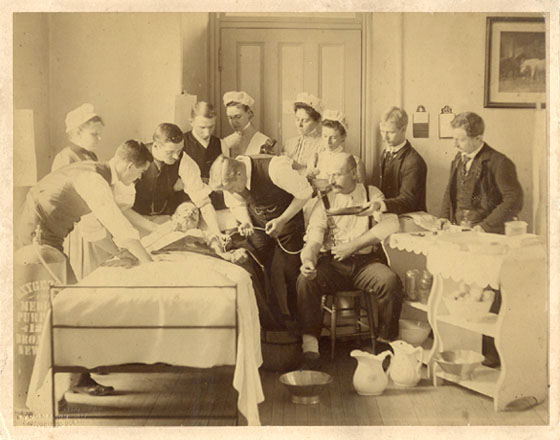

This historic image, the first photo document of a blood transfusion was taken at Bellevue Hospital by the staff photographer O. G. Mason in the 1870's (blind stamped : Bellevue Hospital Photographic Department; N.Y. City; O. G. Mason). The participants were arranged by the photographer and probably rehearsed their roles prior to the photo session, bringing into question whether this is an actual procedure that is being depicted or simply a tableau vivant made for promotional or instructional purposes. The patient is seen sipping oxygen through a gutta-percha tube. The device inserted into his arm and into the arm of the donor is an Aveling Apparatus introduced by the British obstetrician James Aveling in 18731 for treatment of postpartum hemorrhage and is comprised of two silver canulae connected by a rubber tube with a bulb and stopcocks.
Mason's photograph was first published in the journal Transfusion2 for an article titled The first photograph of blood transfusion, by Dr. Paul J. Schmidt who writes :
The Aveling apparatus is being handled with care, its tubing being pinched by the fingers of the chief operator and his cautious assistant. However, the photograph shows that the needles have been placed incorrectly. Early direct transfusions were done as shown in the Aveling illustration, with the donor needle pointed toward the hand to capture the venous return of blood and the transfusing needle in the recipient pointed toward the heart, in the direction of the venous flow. The Bellevue staff has placed both needles in the wrong orientation.
Dr. Schmidt also notes that the uniforms worn by the nurses are in a style that was adopted in 1876, a fact which helps in dating the photograph. The diagram that Dr. Schmidt refers to appeared in the Obstetrical Journal of Great Britain (op. cit.) and was republished in a major article on transfusion written by Dr. James R. Chadwick in 1874 for BMSJ3 that included very clear instructions for the placement of the Aveling device. The staff physicians at Bellevue would have read this article and understood the proper placement of the canulae and so it is reasonable to assume that the physicians in the photograph are less experienced first year students who were collared by Mason for the photo session. This does not diminish the beauty of the composition which has dramatic allusions to Leonardo's The Last Supper, however, it does explain the obscurity of the image and why it was never published.
1 Aveling, James H, "Immediate transfusion in England," Obstetrical
Journal of Great Britain & Ireland ; London: J. & A. Churchill], 1873; vol. 1,
pp 289-94.
2 Schmidt, Paul J., M.D., "The first photograph of blood transfusion,"
Transfusion ; www.Transfusion.org, July 2001 ; vol. 41: pp 968-969.
3 Chadwick, James R., M.D., "Transfusion"
Boston Medical & Surgical Journal ; Boston: David Clapp and Son, 1874 ;
vol. xci, no. 2. (July 9, 1874): pp 25-32.
